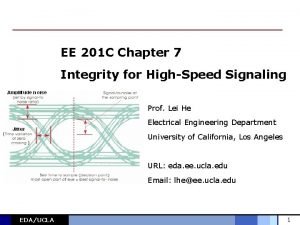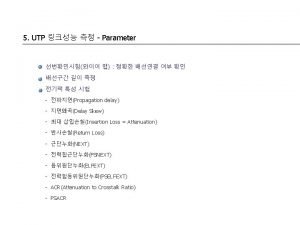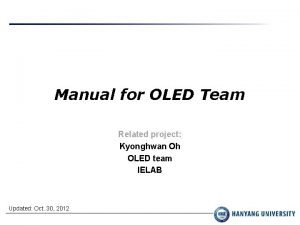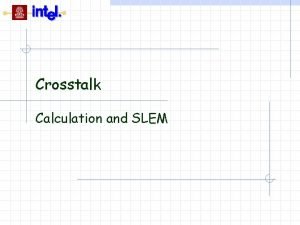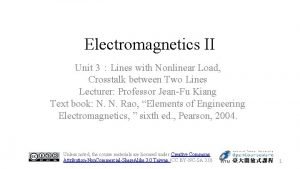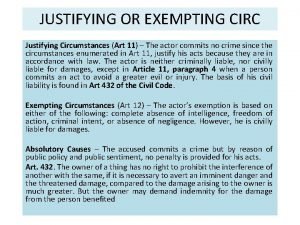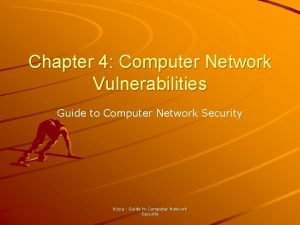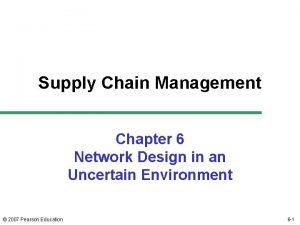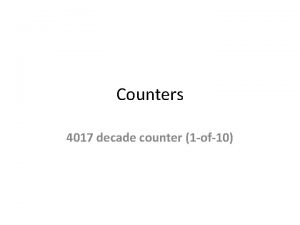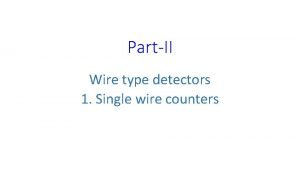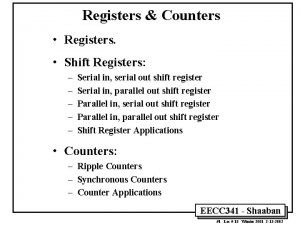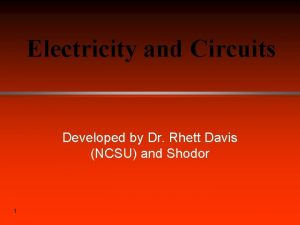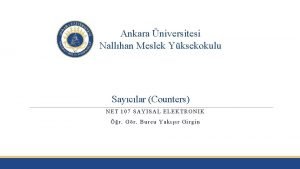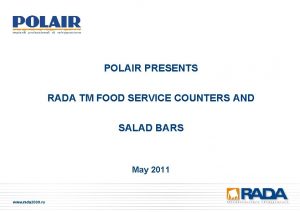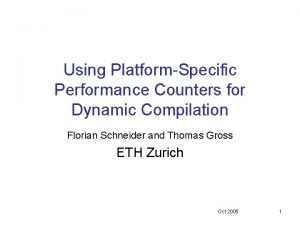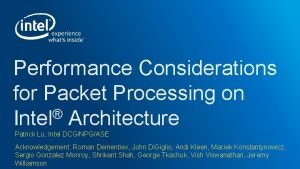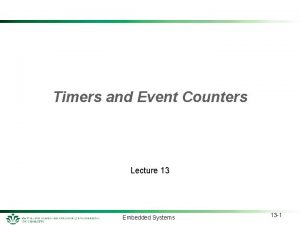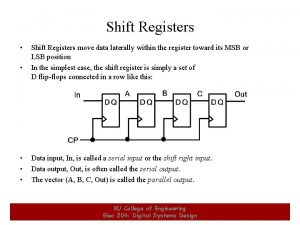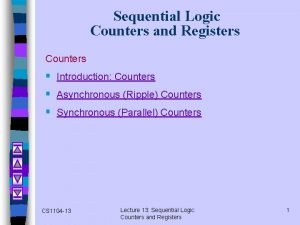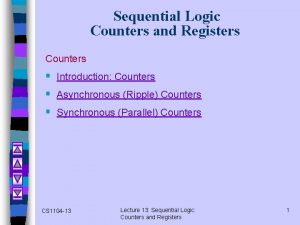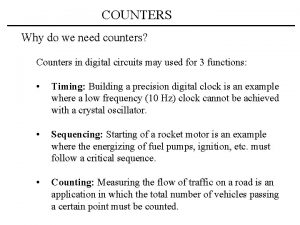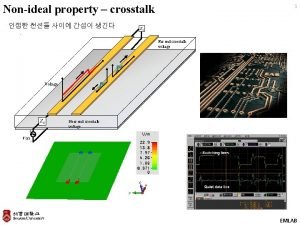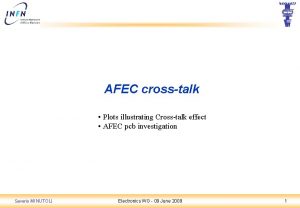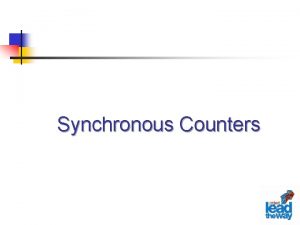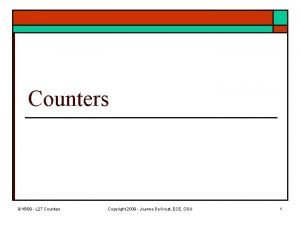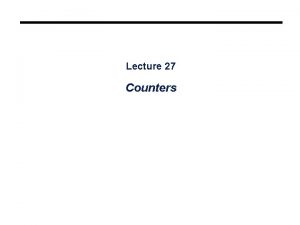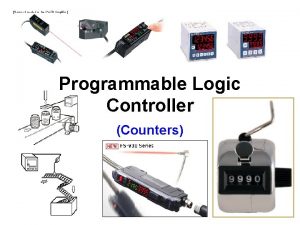Mitigating Wordline Crosstalk using Adaptive Trees of Counters






























- Slides: 30

Mitigating Wordline Crosstalk using Adaptive Trees of Counters Mohammad Seyedzadeh, Alex Jones, Rami Melhem University of Pittsburgh

Wordline Crosstalk in DRAM Scaling ✔ High Memory Capacity ✖ Voltage Fluctuations DRAM Cells DRCAT: Dynamically Reconfigured Counter based Adaptive Tree Deep-scaled DRAM Cells 2

Wordline Crosstalk in DRAM Row of Cells Wordline Victim Row Aggressor Row Victim Row DRAM Cells Deep-scaled DRAM Cells DRAM Bank • The malicious exploit of this crosstalk by repeatedly accessing a row to induce this effect is known as row hammering. DRCAT: Dynamically Reconfigured Counter based Adaptive Tree 2

Outline • Wordline Crosstalk in DRAM • Probabilistic and Deterministic Solutions • CAT: Counter based Adaptive Tree • Evaluation • Conclusion DRCAT: Dynamically Reconfigured Counter based Adaptive Tree 3

Wordline Crosstalk in DRAM: Related Work Probabilistic Approach Deterministic Approach Deep-scaled DRAM Cells Probabilistic Row Activation (PRA) DRCAT: Dynamically Reconfigured Counter based Adaptive Tree Static Counter Assignment (SCA) 4

Probabilistic Row Activation (PRA) Probabilistic Approach RNG(p) Deep-scaled DRAM Cells • Using a Random Number Generator to refresh the victim rows with the probability of ‘p’. DRCAT: Dynamically Reconfigured Counter based Adaptive Tree 5

PRA Failure Probability for 5 years Probabilistic Row Activation (PRA) Pseudo Random Number RNG Generator (PRNG) LFSR-based Refresh threshold: # of aggressor row accesses before read disturbance errors occur in victim rows. DRCAT: Dynamically Reconfigured Counter based Adaptive Tree 6

Static Counter Assignment (SCA) C 0 . . Cm Cn . . . CN-1 Deep-scaled DRAM Cells ining a t n i a to m Power unters Co e Precis wer h Po Refres DRCAT: Dynamically Reconfigured Counter based Adaptive Tree Deep-scaled DRAM Cells Power t o maint ai Counter ning s Conser va Refresh tive Power 7

Static Counter Assignment (SCA) Unutilized Counters • Non-uniform row access patterns in DRAM banks because of data locality DRCAT: Dynamically Reconfigured Counter based Adaptive Tree 8

How to Efficiently Leverage Counters in the Crosstalk Mitigation? DRCAT: Dynamically Reconfigured Counter based Adaptive Tree 8

Our Solution: Counter-based Adaptive Tree (CAT) Row Address Active Counter Expired Counter DRAM BANK (N rows) DRCAT: Dynamically Reconfigured Counter based Adaptive Tree 9

Our Solution: Counter-based Adaptive Tree (CAT) Row Address Active Counter Expired Counter DRAM BANK (N rows) DRCAT: Dynamically Reconfigured Counter based Adaptive Tree 10

CAT: Counter based Adaptive Tree ² PRCAT: Periodically Reset CAT Ø Burst Refresh Mechanism Ø Reset CAT at the end of each refresh Interval ² DRCAT: Dynamically Reconfigured CAT Ø Distributed Refresh Mechanism Ø Reconfigure CAT during consecutive refresh intervals DRCAT: Dynamically Reconfigured Counter based Adaptive Tree 11

PRCAT: Periodically Reset CAT Burst Refresh C 0 64 ms DRCAT: Dynamically Reconfigured Counter based Adaptive Tree 64 ms 12

PRCAT: Periodically Reset CAT C 0 I 0 Burst Refresh C 1 C 0 64 ms DRCAT: Dynamically Reconfigured Counter based Adaptive Tree 64 ms 12

PRCAT: Periodically Reset CAT I 0 I 1 C 0 I 2 I 3 I 4 C 1 I 5 Burst Refresh C 2 C 3 C 6 C 4 C 5 64 ms DRCAT: Dynamically Reconfigured Counter based Adaptive Tree 64 ms 12

PRCAT: Periodically Reset CAT C 0 I 1 C 0 I 2 I 3 I 4 C 1 I 5 Burst Refresh C 2 C 6 I 6 C 3 C 4 C 6 C 7 C 5 Reset CATthe Root Build CAT from 64 ms DRCAT: Dynamically Reconfigured Counter based Adaptive Tree 64 ms 12

DRCAT: Dynamically Reconfigured CAT I 0 I 1 C 0 I 2 I 3 I 4 C 1 I 5 Distributed Refresh C 2 C 3 C 4 I 6 C 7 C 5 64 ms DRCAT: Dynamically Reconfigured Counter based Adaptive Tree 64 ms 13

DRCAT: Dynamically Reconfigured CAT I 0 I 1 C 0 I 2 I 3 I 4 C 1 I 5 C 4 C 5 I 6 C 6 I 5 C 7 C 2 Distributed Refresh C 2 C 3 • During each row access, the tree structure is traversed sequentially by chasing the pointers to find the counter assigned to a specific row address. 64 ms DRCAT: Dynamically Reconfigured Counter based Adaptive Tree 13

Experimental Settings USIMM Simulator: Two 3. 2 GHz cores, 2 channels(each 8 GB DIMM), 1 rank/channel 8 banks/rank, 64 K rows/bank Synopsys Design Compiler Power Overhead PARSEC, SPEC, Commercial and Biobench DRCAT: Dynamically Reconfigured Counter based Adaptive Tree Performance Overhead Kernel Malicious Attack 14

Power Overhead 30% 25% Probabilistic Row Activation Static Counter Assignment PRCAT DRCAT 20% 15% 10% 5% BIO Mean tigr SPEC mum leslie libq MTF MTC freq PARSEC face ferret black COMM str fluid swapt com 5 com 4 com 3 com 2 com 1 0% • Power overhead for DRCAT in dual-core systems is 4. 5%, which is an improvement over the 12% and 13% incurred in PRA and SCA. DRCAT: Dynamically Reconfigured Counter based Adaptive Tree 15

Performance Overhead 4% 3% Probabilistic Row Activation Static Counter Assignment PRCAT DRCAT 2% 1% BIO Mean tigr SPEC mum leslie libq MTF MTC freq PARSEC face ferret black COMM str fluid swapt com 5 com 4 com 3 com 2 com 1 0% • DRCAT, PRCAT and PRA incur very low performance overhead (<0. 5%). DRCAT: Dynamically Reconfigured Counter based Adaptive Tree 16

Sensitivity Analysis ² Mapping Policy & Number of Cores • DRCAT reduces the power overhead in quad-core systems to 7%, which is an improvement over the 21% and 18% incurred in SCA and PRA. ² Refresh Thresholds • Scaling down DRAM technology exacerbates the crosstalk problem leading to a decrease in the refresh threshold. DRCAT: Dynamically Reconfigured Counter based Adaptive Tree 17

Performance Overhead under Malicious attacks <0. 9% • As expected, more intensive attacks leads to higher ETO since it causes more refreshes. DRCAT: Dynamically Reconfigured Counter based Adaptive Tree 18

Conclusion • Demonstrated that a small number of counters can be implemented on chip to mitigate wordline crosstalk. • Proposed a non-uniform counter assignment, Counter-Based Adaptive Tree, to more precisely determine the aggressor rows. • Introduced a scheme, DRCAT, for dynamically reconfiguring the CAT to track the temporal changes in memory access patterns. • DRCAT avoids wordline crosstalk during normal execution and protects against malicious attacks. DRCAT: Dynamically Reconfigured Counter based Adaptive Tree 19

Thank you for your attention! Question? DRCAT: Dynamically Reconfigured Counter based Adaptive Tree 20

Backup Slides

Hardware Overhead • Hardware energy (per bank) and area of DRCAT, PRCAT and SCA for different number of counters • The specification of the PRNG used for PRA. The reported energy for PRNG (eng_PRNG) is for generating 9 -bits per row access. Energy: dynamic (n. J per row access) and static (n. J per refresh interval) M DRCAT PRCAT Area (mm 2) SCA DRCAT PRCAT SCA PRNG dynamic static 32 3. 05 E-04 5. 77 E+03 2. 91 E-04 5. 55 E+03 1. 41 E-04 3. 16 E+03 3. 16 E-02 3. 04 E-02 1. 86 E-02 Area 4. 0 E-3 64 4. 30 E-04 1. 39 E+04 4. 09 -04 1. 32 E+04 1. 92 E-04 8. 81 E+03 6. 12 E-02 5. 86 E-02 4. 04 E-02 Throughput(Gbps) 2. 4 128 5. 83 E-04 2. 77 E+04 5. 50 E-04 2. 63 E+04 2. 22 E-04 1. 44 E+04 1. 16 E-01 1. 11 E-01 6. 04 E-02 Power(m. W) 7 256 8. 72 E-04 5. 44 E+04 8. 25 E-04 5. 13 E+04 3. 12 E-04 2. 39 E+04 2. 23 E-01 2. 11 E-01 1. 00 E-01 Eff. (nj/b) 2. 9 E-3 512 1. 17 E-03 1. 06 E+05 1. 10 E-03 1. 02 E+05 4. 25 E-04 4. 52 E+04 3. 93 E-01 3. 75 E-01 1. 72 E-01 Eng_PRNG(nj) 2. 62 E-2 DRCAT: Dynamically Reconfigured Counter based Adaptive Tree 21

Static Counter Assignment (SCA) DRCAT: Dynamically Reconfigured Counter based Adaptive Tree 22

Sensitivity to the Maximum CAT depth • Crosstalk mitigation power overhead per bank for DRCAT using from 32 to 512 counters and different maximum CAT levels (6 to 14). DRCAT: Dynamically Reconfigured Counter based Adaptive Tree 23
 How to subtract integers using counters
How to subtract integers using counters Advantages of garbage collection
Advantages of garbage collection Crosstalk programa de televisión
Crosstalk programa de televisión Near end crosstalk
Near end crosstalk Attenuation to crosstalk ratio
Attenuation to crosstalk ratio Oled crosstalk
Oled crosstalk Near end crosstalk
Near end crosstalk Crosstalk calculator
Crosstalk calculator Crosstalk
Crosstalk Article 11 justifying circumstances
Article 11 justifying circumstances Computer network vulnerabilities
Computer network vulnerabilities Examples of mitigating factors
Examples of mitigating factors Shipboard oil pollution emergency plan
Shipboard oil pollution emergency plan Network design decisions using decision trees
Network design decisions using decision trees What is counters
What is counters Wire counters
Wire counters Hypochromic red cell
Hypochromic red cell Draw counters
Draw counters 74x169 counter
74x169 counter Falstad counter
Falstad counter 4 bitlik asenkron yukarı sayıcı
4 bitlik asenkron yukarı sayıcı Food service counters
Food service counters Java performance counters
Java performance counters Mod-10 counter
Mod-10 counter Component counters
Component counters Intel npg
Intel npg Timer and counting devices in embedded systems
Timer and counting devices in embedded systems Parallel load
Parallel load Registers
Registers Counters shift registers
Counters shift registers Counters shift registers
Counters shift registers



